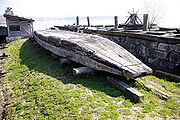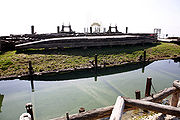
Bevaix Boat
Encyclopedia

Bevaix
Bevaix is a municipality in the district of Boudry in the canton of Neuchâtel in Switzerland.-History:Bevaix is first mentioned in 998 as in villa Bevacensi. In 1139 it was mentioned as Betuaci....
, Lake Neuchatel
Lake Neuchâtel
Lake Neuchâtel is a lake in Romandy, Switzerland . The lake lies mainly in the canton of Neuchâtel, but is also shared by the cantons of Vaud, of Fribourg, and of Bern....
, Switzerland
Switzerland
Switzerland name of one of the Swiss cantons. ; ; ; or ), in its full name the Swiss Confederation , is a federal republic consisting of 26 cantons, with Bern as the seat of the federal authorities. The country is situated in Western Europe,Or Central Europe depending on the definition....
. The remains of the ship, and a modern reconstruction, are on display at the Laténium
Laténium
The Laténium is an archeology museum located in Hauterive, a suburb of Neuchâtel. Its name refers to the La Tène culture.The Laténium is composed of a 2 500 m² parc, and a museum building which also harbours the archaeological section of the University of Neuchâtel...
archeology museum.
The boat

Oak
An oak is a tree or shrub in the genus Quercus , of which about 600 species exist. "Oak" may also appear in the names of species in related genera, notably Lithocarpus...
planks and measured 19.4 metres (63.6 ft) in length and around 2.9 metres (9.5 ft) in beam. It is characterized by a flat bottom and the complete absence of a keel
Keel
In boats and ships, keel can refer to either of two parts: a structural element, or a hydrodynamic element. These parts overlap. As the laying down of the keel is the initial step in construction of a ship, in British and American shipbuilding traditions the construction is dated from this event...
or any central plank. Its four principle bottom planks were arranged one besides the other in a way that the first plank forms the stern
Stern
The stern is the rear or aft-most part of a ship or boat, technically defined as the area built up over the sternpost, extending upwards from the counter rail to the taffrail. The stern lies opposite of the bow, the foremost part of a ship. Originally, the term only referred to the aft port section...
and the last one forms the bow
Bow (ship)
The bow is a nautical term that refers to the forward part of the hull of a ship or boat, the point that is most forward when the vessel is underway. Both of the adjectives fore and forward mean towards the bow...
. The beam of the boat was determined by the addition of L-shaped bilge
Bilge
The bilge is the lowest compartment on a ship where the two sides meet at the keel. The word was coined in 1513.-Bilge water:The word is sometimes also used to describe the water that collects in this compartment. Water that does not drain off the side of the deck drains down through the ship into...
strake
Strake
A strake is part of the shell of the hull of a boat or ship which, in conjunction with the other strakes, keeps the sea out and the vessel afloat...
s. These strakes allowed a direct transition between the flat bottom and the sides of the boat. The spaces left between the bilge strakes and the four large bottom planks were filled by two planks with an irregular outline. The purpose of these last planks was to obtain appropriate symmetry
Symmetry
Symmetry generally conveys two primary meanings. The first is an imprecise sense of harmonious or aesthetically pleasing proportionality and balance; such that it reflects beauty or perfection...
of the bottom. The upper strakes, those above the bilge strake, did not survive. However, evidence of caulking
Caulking
Caulking is one of several different processes to seal joints or seams in various structures and certain types of piping. The oldest form of caulking is used to make the seams in wooden boats or ships watertight, by driving fibrous materials into the wedge-shaped seams between planks...
, found on the upper edges of the bilge strakes clearly suggests that the sides had been heightened by at least one or two strakes. This, in turn, lead to estimates suggesting that the maximum height of the boat was about 0.8 to 0.9 m (2.6 to 3 ft).
Framing
Twenty-two pairs of internal frames, also made of oak, were arranged head to tail to give almost vertical sides. All the pairs consisted of two timbers, each made of a single naturally bent timber which was cut from a tree junction (main trunk as floor support, and branch junction as side support). In every case, frames were always installed in pairs covering the whole length of the bottom, but alternatively supporting only one side of the hull. The only exception is a sixth pair, which was a single piece of oak with a mortise cutMortise and tenon
The mortise and tenon joint has been used for thousands of years by woodworkers around the world to join pieces of wood, mainly when the adjoining pieces connect at an angle of 90°. In its basic form it is both simple and strong. Although there are many joint variations, the basic mortise and tenon...
in the center to function as a mast-step. The framing was fastened to the planks with some 300 iron nails driven from inside. They passed first through the frame, and then the strakes. Any projecting end was clenched at the right angle (double-clenched according to some sources).
Caulking
The Bevaix boat presents a very distinctive caulking technique, which clearly differentiated it from similar finds of this period from other parts of EuropeEurope
Europe is, by convention, one of the world's seven continents. Comprising the westernmost peninsula of Eurasia, Europe is generally 'divided' from Asia to its east by the watershed divides of the Ural and Caucasus Mountains, the Ural River, the Caspian and Black Seas, and the waterways connecting...
. It was observed that caulking was consistently present between all the planks of the boat. First, a string was inserted into the seam. Next, this string was covered by layer of mosses, which in turn was held by a wooden lath
Lath
A lath is a thin, narrow strip of some straight-grained wood or other material, including metal or gypsum. A lattice, or lattice-work, is a criss-crossed or interlaced arrangement of laths, or the pattern made by such an arrangement...
that was secured with thousands of little caulking nails, inserted into the seams from the outside.

